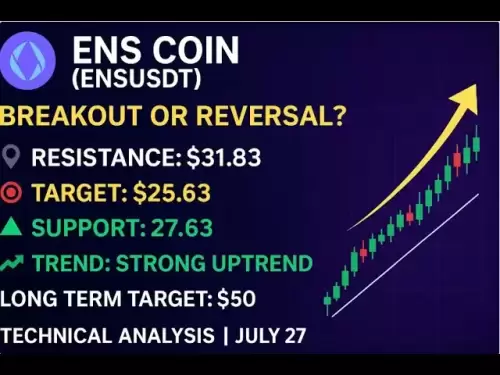-
 Bitcoin
Bitcoin $117900
0.31% -
 Ethereum
Ethereum $3766
0.28% -
 XRP
XRP $3.176
-0.31% -
 Tether USDt
Tether USDt $1.000
0.00% -
 BNB
BNB $795.6
1.51% -
 Solana
Solana $186.8
-1.09% -
 USDC
USDC $0.9999
-0.01% -
 Dogecoin
Dogecoin $0.2353
-1.33% -
 TRON
TRON $0.3226
1.49% -
 Cardano
Cardano $0.8172
-1.08% -
 Sui
Sui $4.178
3.06% -
 Hyperliquid
Hyperliquid $43.05
-3.39% -
 Stellar
Stellar $0.4367
-0.57% -
 Chainlink
Chainlink $18.62
1.47% -
 Hedera
Hedera $0.2828
6.63% -
 Bitcoin Cash
Bitcoin Cash $584.7
5.65% -
 Avalanche
Avalanche $24.81
2.53% -
 Litecoin
Litecoin $112.8
-0.88% -
 UNUS SED LEO
UNUS SED LEO $8.975
-0.08% -
 Shiba Inu
Shiba Inu $0.00001395
-1.07% -
 Toncoin
Toncoin $3.285
-1.05% -
 Ethena USDe
Ethena USDe $1.001
0.01% -
 Polkadot
Polkadot $4.123
0.76% -
 Uniswap
Uniswap $10.49
-0.18% -
 Monero
Monero $326.5
0.14% -
 Dai
Dai $0.9999
-0.02% -
 Bitget Token
Bitget Token $4.576
0.34% -
 Pepe
Pepe $0.00001247
-1.55% -
 Cronos
Cronos $0.1400
3.77% -
 Aave
Aave $295.1
-0.73%
Is the price of USDT consistent on different exchanges?
USDT prices fluctuate slightly across exchanges due to factors like liquidity, fees, and market sentiment; arbitrage bots quickly exploit these minor discrepancies, though risks remain.
Feb 28, 2025 at 12:19 pm
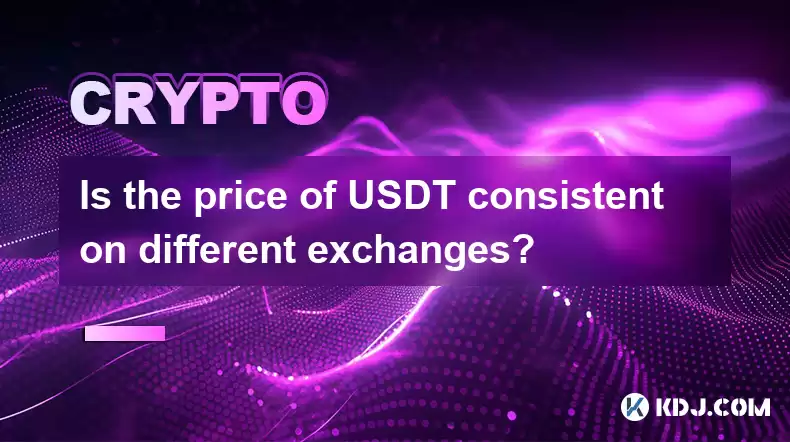
Is the Price of USDT Consistent on Different Exchanges?
Key Points:
- Arbitrage Opportunities: Slight price discrepancies between USDT on different exchanges exist, creating opportunities for arbitrage. However, these discrepancies are usually small and fleeting due to the high trading volume and the efficiency of arbitrage bots.
- Factors Influencing Price Discrepancies: Several factors contribute to inconsistencies, including varying liquidity levels across exchanges, trading fees, withdrawal fees, and the specific order book dynamics on each platform. Network congestion on the underlying blockchain (e.g., Ethereum, Tron) can also temporarily impact price consistency.
- Exchange Reputation and Regulatory Environment: The reputation and regulatory environment of an exchange can subtly influence the perceived value of USDT. Exchanges with stronger reputations and stricter regulatory compliance may experience slightly higher or more stable USDT prices compared to those with less stringent oversight.
- Tether's Reserves and Transparency: The ongoing debate surrounding Tether's reserves and the transparency of its operations can indirectly influence USDT pricing on various exchanges. Concerns about the backing of USDT can lead to temporary price fluctuations across platforms.
- Market Sentiment and Speculation: General market sentiment and speculation surrounding Tether and the broader cryptocurrency market can significantly impact the price of USDT across different exchanges. Negative news or concerns can trigger sell-offs, leading to price drops, while positive news can drive price increases.
Detailed Explanation:
- Arbitrage Opportunities and Their Limitations:
The theoretical price of USDT should be consistently pegged to the US dollar at a 1:1 ratio. However, in reality, minor price discrepancies often appear across different cryptocurrency exchanges. These slight differences represent arbitrage opportunities. Arbitrageurs, individuals or automated trading bots, capitalize on these inconsistencies by simultaneously buying USDT on an exchange where it's cheaper and selling it on an exchange where it's more expensive. This process helps to maintain price equilibrium across different exchanges. However, these opportunities are typically short-lived and require sophisticated trading strategies, fast execution speeds, and a deep understanding of exchange fees and network transaction costs. The profit margins are usually small, making it a high-volume, low-margin business. The speed of arbitrage bots is a significant factor; any price discrepancy is often eliminated within seconds or minutes due to the immediate response of these automated systems. The sheer volume of USDT traded globally also contributes to the rapid correction of price inconsistencies. Large trades can temporarily shift prices, but the overall market quickly rebalances itself. While arbitrage exists, it’s crucial to remember that the profit margins are often eaten up by fees, and attempting arbitrage without proper knowledge and tools can result in losses. The market is highly competitive, and only the most efficient and well-capitalized arbitrageurs can consistently profit from these fleeting opportunities. Furthermore, unexpected market events or sudden changes in liquidity can wipe out potential profits and even lead to losses. Therefore, while arbitrage opportunities exist theoretically, they are often challenging to exploit successfully.
- Factors Influencing Price Discrepancies: Liquidity, Fees, and Order Book Dynamics:
Several interconnected factors contribute to the occasional inconsistencies in USDT pricing across different exchanges. Firstly, liquidity plays a crucial role. Exchanges with higher trading volumes and deeper order books tend to have more stable and consistent USDT prices. This is because a higher liquidity pool absorbs buy and sell orders without significantly impacting the price. Conversely, exchanges with lower liquidity may experience more significant price fluctuations in response to even small trading activities. Secondly, trading fees and withdrawal fees vary between exchanges. These fees directly impact the effective price of USDT. A higher trading fee on one exchange might make USDT appear slightly more expensive compared to another exchange with lower fees, even if the base price is nominally the same. Withdrawal fees also affect the final price received after transferring USDT to an external wallet or another exchange. Thirdly, the order book dynamics on each exchange contribute to price discrepancies. The order book reflects the outstanding buy and sell orders at various price points. The interplay of these orders, influenced by market sentiment and trading activity, can lead to temporary price variations. A sudden influx of sell orders on one exchange might temporarily depress the price, while a lack of buy orders on another might push the price slightly higher. These variations are usually short-lived and quickly corrected through arbitrage. The specific algorithms used by exchanges to match buy and sell orders also play a subtle role in influencing price discrepancies. Finally, network congestion on the underlying blockchain (e.g., Ethereum, Tron) can significantly impact price consistency. High transaction fees and slow confirmation times during periods of network congestion can delay the execution of arbitrage trades, allowing temporary price differences to persist.
- Exchange Reputation and Regulatory Environment:
The reputation of a cryptocurrency exchange and the regulatory environment in which it operates can subtly influence the perceived value and, consequently, the price of USDT on that platform. Exchanges with a strong track record of security, transparency, and compliance with relevant regulations are generally considered more trustworthy. This perceived trustworthiness can indirectly lead to a slightly higher or more stable USDT price compared to exchanges with a less robust reputation or weaker regulatory oversight. Investors might be willing to pay a slightly higher price for USDT on a reputable exchange due to the reduced risk of fraud, hacks, or regulatory issues. Conversely, exchanges operating in jurisdictions with lax regulatory frameworks or those with a history of security breaches might experience a slightly lower or more volatile USDT price as investors perceive a higher risk. This is not always a direct correlation, but rather a reflection of the overall market sentiment and investor confidence in the exchange itself. Furthermore, the regulatory landscape is constantly evolving, and changes in regulations can influence investor behavior and subsequently impact USDT pricing on affected exchanges. Regulatory scrutiny can increase investor confidence, while uncertainty can lead to volatility.
- Tether's Reserves and Transparency:
The ongoing debate surrounding Tether's reserves and the transparency of its operations has a significant, albeit indirect, influence on the price of USDT across various exchanges. Tether, the issuer of USDT, claims that each USDT is backed by a corresponding amount of US dollar reserves. However, the lack of complete transparency regarding the composition and verification of these reserves has led to ongoing scrutiny and skepticism from various quarters. Concerns about the true backing of USDT can trigger periods of increased volatility and temporary price fluctuations across different exchanges. Negative news or reports questioning the adequacy or composition of Tether's reserves can lead to sell-offs, depressing the price of USDT across multiple platforms. Conversely, positive news or announcements aimed at improving transparency can boost investor confidence and potentially increase the price. This influence is primarily driven by market sentiment and investor confidence, rather than a direct impact on the underlying value of the token itself. The ongoing debate highlights the importance of transparency and accountability in the cryptocurrency market.
- Market Sentiment and Speculation:
Market sentiment and speculation surrounding Tether and the broader cryptocurrency market play a crucial role in influencing the price of USDT across different exchanges. Positive news or events related to Tether or the cryptocurrency market in general can lead to increased demand for USDT, driving its price upward on multiple platforms. Conversely, negative news, such as regulatory crackdowns, security breaches, or concerns about the stability of the cryptocurrency market, can trigger sell-offs and depress the price of USDT across exchanges. Speculative trading activity can also contribute to price fluctuations. Traders might anticipate future price movements based on various factors, including news events, technical analysis, or broader market trends. This speculative activity can lead to temporary price discrepancies between exchanges, as traders might buy or sell USDT on different platforms based on their individual perceptions of risk and reward. The interconnectedness of the cryptocurrency market means that events affecting one cryptocurrency or exchange can ripple through the entire ecosystem, impacting the price of USDT across all platforms.
FAQs:
Q: If USDT prices vary, how can I profit from this?
A: Profiting from USDT price discrepancies involves arbitrage trading. This requires sophisticated trading strategies, access to multiple exchanges, and fast execution speeds to capitalize on the often fleeting differences. It's crucial to understand and factor in trading fees and network transaction costs, as these can quickly erase any potential profit margins. Attempting arbitrage without the necessary knowledge and tools can lead to significant losses.
Q: Are these price differences significant enough to warrant concern?
A: Usually, the price differences are minimal and represent only small percentage deviations from the 1:1 peg. While arbitrage opportunities exist, they are typically small and short-lived. Significant and persistent deviations would likely indicate serious underlying issues with Tether or the market.
Q: Which exchanges are most reliable for USDT trading?
A: Choosing a reliable exchange depends on individual risk tolerance and preferences. Factors to consider include the exchange's reputation, security measures, trading volume, regulatory compliance, and fees. Research and due diligence are essential before choosing any exchange for trading. There is no single "best" exchange, as different exchanges cater to different needs and preferences.
Q: Is it risky to hold a large amount of USDT?
A: Holding any significant amount of any cryptocurrency carries inherent risks. While USDT aims for a 1:1 peg with the USD, its value is not guaranteed and is subject to market forces and the stability of Tether itself. Diversification of assets is always recommended to mitigate risk.
Q: How often do these price discrepancies occur?
A: Minor price discrepancies are relatively common, though often very small and short-lived. Larger deviations are less frequent and often trigger immediate arbitrage activity to correct the imbalance. The frequency and magnitude of these discrepancies are influenced by various factors, including market volatility, liquidity levels, and news events.
Disclaimer:info@kdj.com
The information provided is not trading advice. kdj.com does not assume any responsibility for any investments made based on the information provided in this article. Cryptocurrencies are highly volatile and it is highly recommended that you invest with caution after thorough research!
If you believe that the content used on this website infringes your copyright, please contact us immediately (info@kdj.com) and we will delete it promptly.
- Bitcoin, Ruvi AI, and CoinMarketCap: Navigating the Future of Crypto
- 2025-07-28 02:30:12
- Dogwifhat (WIF) Eyes Bullish Breakout: Can It Breach $1.20?
- 2025-07-28 02:50:12
- Bitcoin Bounces: How the US-China Tariff Truce Impacts Crypto
- 2025-07-28 02:50:12
- Bitcoin Bull Market: Price Targets and Expert Takes
- 2025-07-28 02:30:12
- Cardano Price Rockets: ADA Jumps Past Resistance, $2 Target in Sight?
- 2025-07-28 01:30:14
- Ruvi AI: The Next Solana? Riding the AI Token Wave on CoinMarketCap
- 2025-07-28 00:50:16
Related knowledge
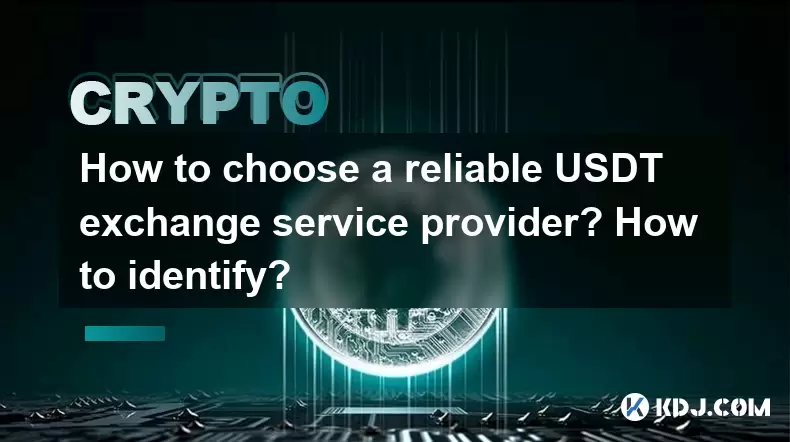
How to choose a reliable USDT exchange service provider? How to identify?
Jun 12,2025 at 03:15pm
Understanding the Role of USDT in Cryptocurrency TradingUSDT (Tether) is one of the most widely used stablecoins in the cryptocurrency market. It is d...
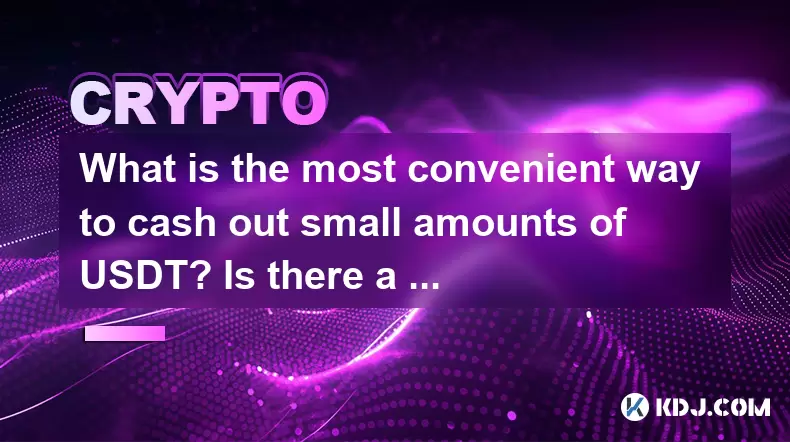
What is the most convenient way to cash out small amounts of USDT? Is there a shortcut?
Jun 11,2025 at 11:00pm
Understanding the Need to Cash Out Small USDT AmountsCashing out small amounts of USDT can be a challenge for many crypto users. Traditional methods o...
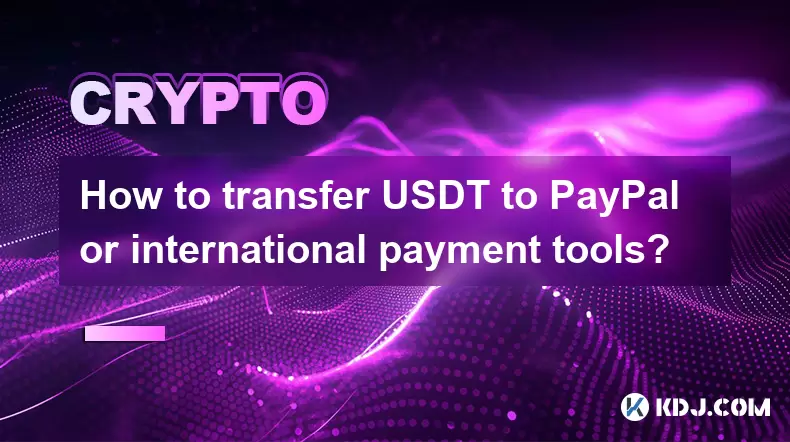
How to transfer USDT to PayPal or international payment tools?
Jun 15,2025 at 05:28am
Understanding the Basics of USDT and PayPal IntegrationUSDT (Tether) is a stablecoin pegged to the US dollar, offering blockchain-based value transfer...
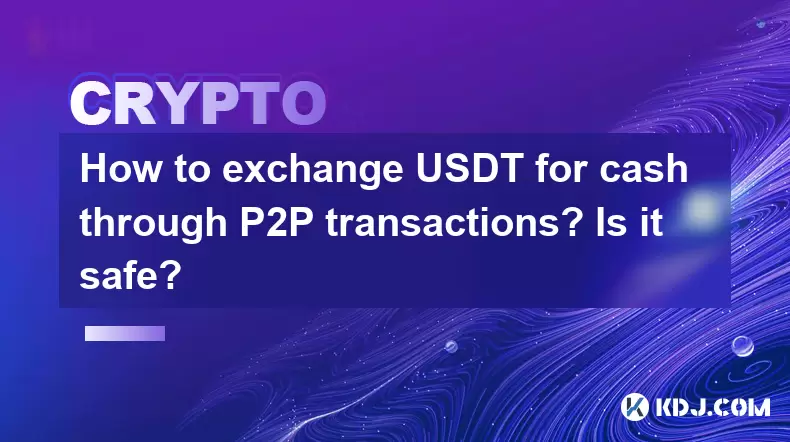
How to exchange USDT for cash through P2P transactions? Is it safe?
Jun 18,2025 at 07:56am
Understanding USDT and P2P TransactionsTether (USDT) is a stablecoin pegged to the value of the US dollar, making it a popular choice for users who wa...
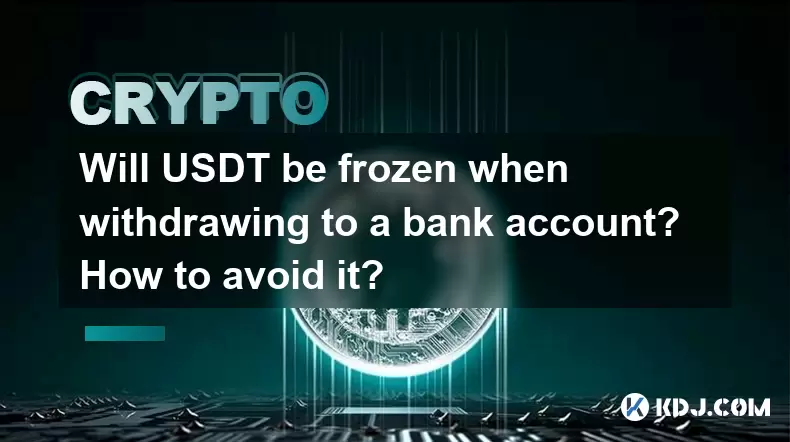
Will USDT be frozen when withdrawing to a bank account? How to avoid it?
Jun 15,2025 at 10:03am
Understanding USDT Withdrawals and Bank Account Freezing RisksWhen users decide to withdraw USDT (Tether) to a bank account, one of the most common co...
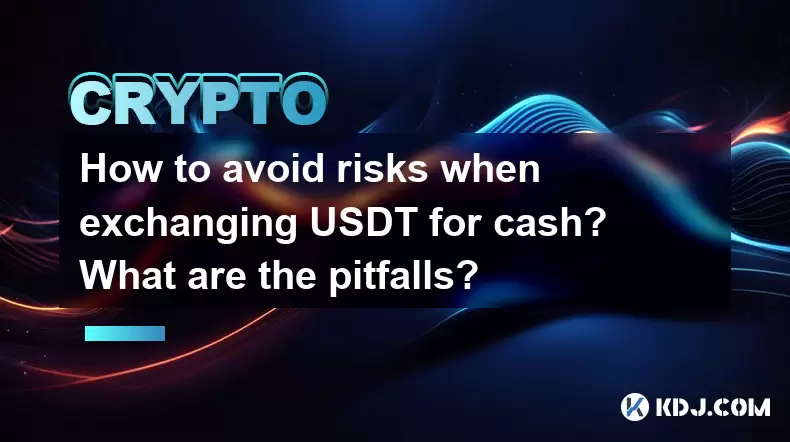
How to avoid risks when exchanging USDT for cash? What are the pitfalls?
Jun 11,2025 at 08:14pm
Understanding the Risks of Exchanging USDT for CashWhen exchanging USDT (Tether) for cash, users must be aware of the potential risks involved. As a s...

How to choose a reliable USDT exchange service provider? How to identify?
Jun 12,2025 at 03:15pm
Understanding the Role of USDT in Cryptocurrency TradingUSDT (Tether) is one of the most widely used stablecoins in the cryptocurrency market. It is d...

What is the most convenient way to cash out small amounts of USDT? Is there a shortcut?
Jun 11,2025 at 11:00pm
Understanding the Need to Cash Out Small USDT AmountsCashing out small amounts of USDT can be a challenge for many crypto users. Traditional methods o...

How to transfer USDT to PayPal or international payment tools?
Jun 15,2025 at 05:28am
Understanding the Basics of USDT and PayPal IntegrationUSDT (Tether) is a stablecoin pegged to the US dollar, offering blockchain-based value transfer...

How to exchange USDT for cash through P2P transactions? Is it safe?
Jun 18,2025 at 07:56am
Understanding USDT and P2P TransactionsTether (USDT) is a stablecoin pegged to the value of the US dollar, making it a popular choice for users who wa...

Will USDT be frozen when withdrawing to a bank account? How to avoid it?
Jun 15,2025 at 10:03am
Understanding USDT Withdrawals and Bank Account Freezing RisksWhen users decide to withdraw USDT (Tether) to a bank account, one of the most common co...

How to avoid risks when exchanging USDT for cash? What are the pitfalls?
Jun 11,2025 at 08:14pm
Understanding the Risks of Exchanging USDT for CashWhen exchanging USDT (Tether) for cash, users must be aware of the potential risks involved. As a s...
See all articles
























